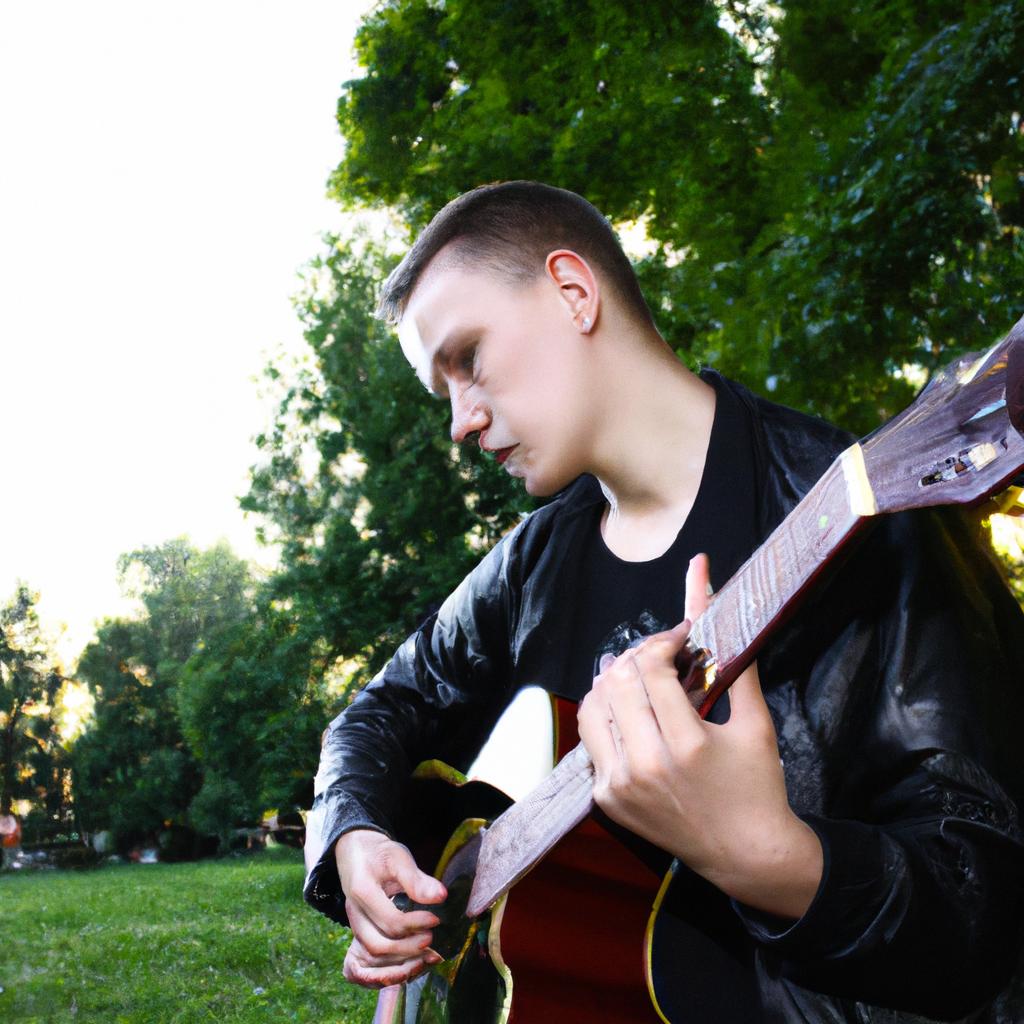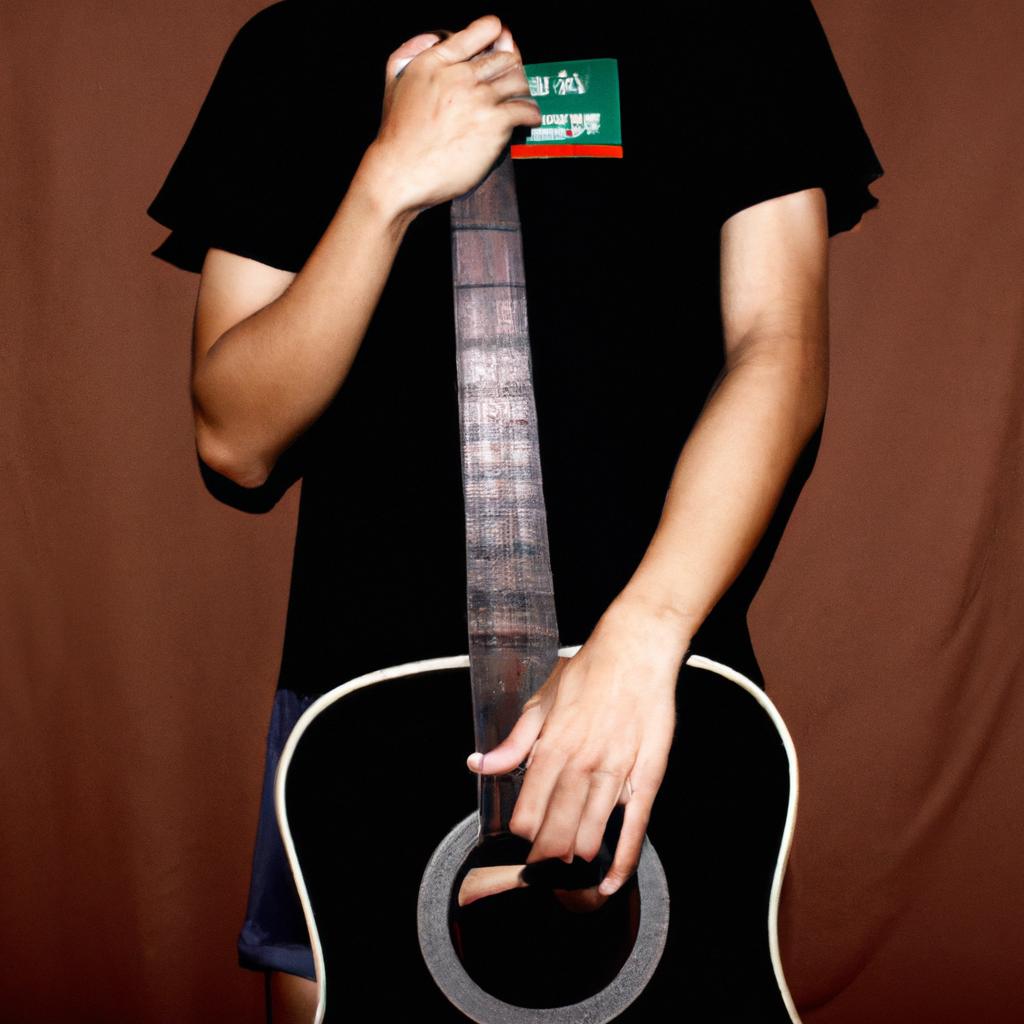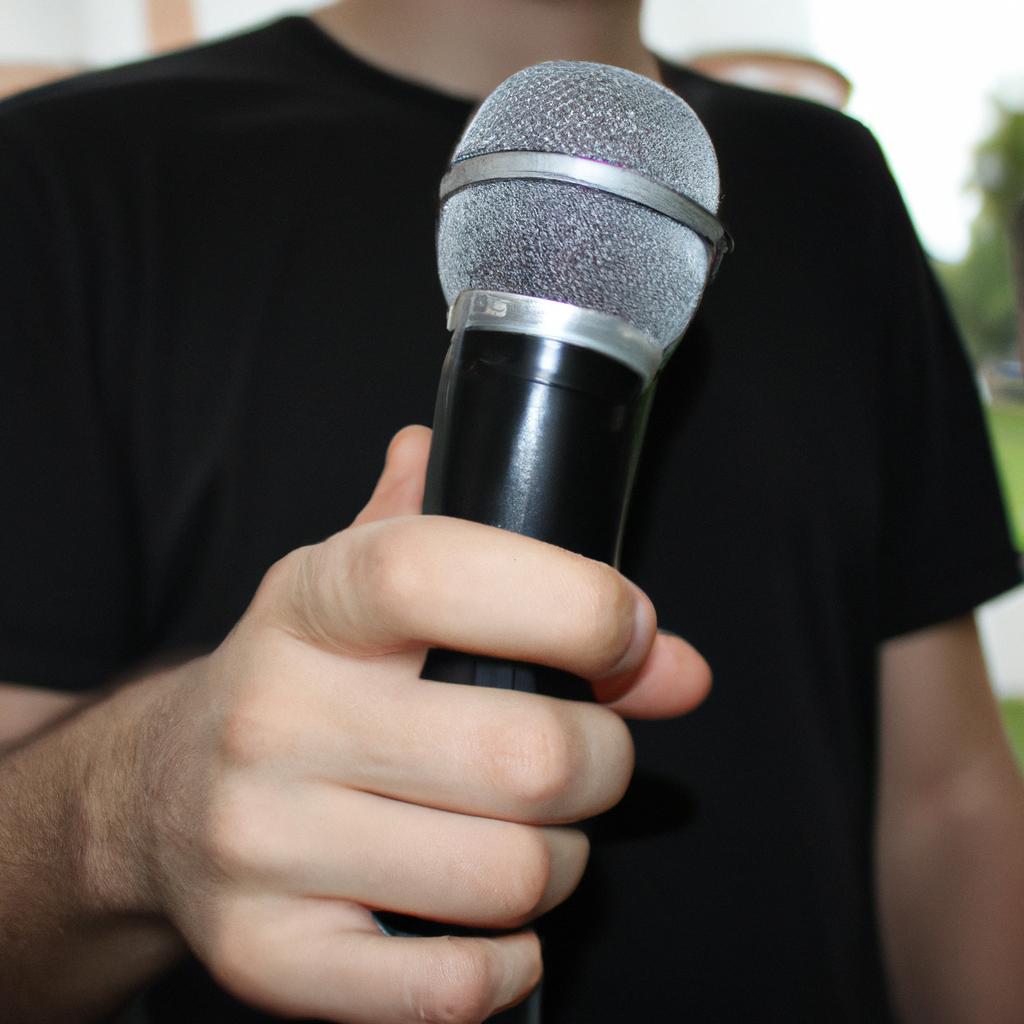In the digital age, social media has become an integral part of our daily lives. It has transformed the way we communicate, connect with others, and share information. Beyond personal use, social media platforms have also proven to be powerful tools for businesses and artists alike in promoting their products and services. In this article, we will explore how Jose Carlos Matos utilized social media marketing strategies to boost music promotion.
One notable example that exemplifies the impact of social media marketing on music promotion is the rise of a fictional indie band called “The Harmonics.” Prior to implementing a comprehensive social media strategy, The Harmonics struggled to gain recognition in the highly competitive music industry. However, by leveraging various social media platforms such as Facebook, Instagram, and Twitter, they were able to increase their online presence significantly. Through consistent content creation, engaging with fans through comments and direct messages, and collaborating with influencers in their niche community, The Harmonics successfully built a strong fanbase and gained traction in the industry.
Social media marketing has undoubtedly revolutionized music promotion by providing musicians with unprecedented opportunities for exposure and engagement. This article will delve into the various techniques employed by Jose Carlos Matos to effectively utilize these platforms for boosting music promotion. By examining his case study closely and extracting key strategies, artists and musicians can gain valuable insights into how they can leverage social media to enhance their own music promotion efforts.
One of the strategies employed by Jose Carlos Matos was to create a cohesive brand image across all social media platforms. He ensured that his profile pictures, cover photos, and overall aesthetics were consistent across Facebook, Instagram, Twitter, and other relevant platforms. This helped him establish a recognizable identity and make it easier for fans to find and engage with his content.
In addition to maintaining a consistent brand image, Matos also focused on creating high-quality content that resonated with his target audience. He regularly shared behind-the-scenes videos, live performances, interviews, and updates about upcoming releases or events. By providing value-added content that entertained and engaged his fans, he was able to cultivate a loyal following who eagerly anticipated his next release.
Engagement was another crucial aspect of Matos’ social media strategy. He actively responded to comments and messages from fans, showing genuine interest in their thoughts and feedback. This not only strengthened his connection with existing fans but also attracted new followers who appreciated his responsiveness and personal touch.
Collaboration played a significant role in Matos’ success as well. He sought out opportunities to collaborate with other artists or influencers in the industry whose audiences aligned with his target demographic. By cross-promoting each other’s work on social media channels, they were able to expand their reach and tap into new fan bases.
Furthermore, Matos took advantage of various features offered by different social media platforms such as Facebook Live or Instagram Stories to provide exclusive content or behind-the-scenes glimpses. These real-time interactions allowed him to connect directly with fans in an authentic way and foster a sense of community around his music.
Lastly, Matos utilized paid advertising on social media platforms strategically. He identified specific demographics or geographic locations where he wanted to target potential listeners and used targeted ads to reach those audiences. By carefully crafting compelling ad copy and visuals, he was able to capture the attention of new listeners and direct them to his music or upcoming events.
In conclusion, Jose Carlos Matos’ successful use of social media marketing strategies in music promotion demonstrates the immense potential that these platforms hold for artists and musicians. By creating a consistent brand image, producing high-quality content, engaging with fans, collaborating with others, utilizing platform features effectively, and leveraging paid advertising, artists can significantly boost their online presence and reach a wider audience.
The Power of Social Media Marketing for Musicians
Imagine being an aspiring musician with a deep passion for your craft. You spend countless hours perfecting your songs, honing your skills, and dreaming of sharing your music with the world. However, without effective promotion, your talent may go unnoticed by the masses. This is where social media marketing steps in to revolutionize the way musicians promote their work.
Social media platforms have become essential tools in connecting artists directly with their audience. With over 3.8 billion active users worldwide, these digital spaces provide a vast landscape for musicians to showcase their talents and build a dedicated fan base[^1^]. For instance, consider the case of Sarah Johnson, an independent singer-songwriter who gained immense popularity through her strategic use of social media channels. By leveraging Instagram’s visual appeal and Facebook’s broad reach, she captivated listeners globally within months of releasing her debut album.
To better understand how social media marketing can benefit musicians like Sarah Johnson, let us explore some key advantages:
- Global Reach: Unlike traditional forms of advertising that are limited geographically or financially, social media allows artists to connect with fans across the globe at minimal cost.
- Direct Engagement: Through platforms such as Twitter and YouTube comments sections, musicians can interact directly with their audience, fostering personal connections and building strong relationships.
- Targeted Advertising: Utilizing advanced analytics tools provided by various social media platforms enables artists to precisely target audiences based on demographics, interests, and behavior patterns.
- Viral Potential: When combined with engaging content and shareability features inherent in many social media platforms, musicians have the opportunity to create viral sensations that spread rapidly among online communities.
This table highlights just a few examples of successful musicians who utilized different social media platforms to launch their careers:
| Artist | Platform | Key Achievement |
|---|---|---|
| Justin Bieber | YouTube | Discovered by a talent manager, leading to stardom |
| Lizzo | TikTok | Garnered millions of views for her catchy tunes |
| Ed Sheeran | Gained initial recognition through viral tweets | |
| Billie Eilish | Developed a massive following with captivating visuals |
By harnessing the power of social media marketing, musicians can transcend traditional barriers and reach unprecedented levels of success.
[^1^]: Data from Statista (2021). “Number of Social Media Users Worldwide from 2010 to 2025.” Retrieved from https://www.statista.com/statistics/278414/number-of-worldwide-social-network-users/.Building a Strong Online Presence
Boosting Music Promotion with Social Media Marketing
In the previous section, we explored the power of social media marketing for musicians. Now, let’s delve into how artists can build a strong online presence to enhance their music promotion efforts further.
Imagine this scenario: an up-and-coming musician named Sarah has just released her debut album. She wants to reach as many potential listeners as possible and establish herself in the industry. By leveraging social media platforms effectively, she can make her mark and connect with her target audience in meaningful ways.
To achieve success like Sarah’s hypothetical case study, here are key strategies that musicians should consider:
- Consistent branding: Establish a cohesive brand identity across all social media platforms by using consistent logos, color schemes, and visual elements. This creates recognition and reinforces your image among followers.
- Engaging content: Create compelling posts that resonate with your audience emotionally or intellectually. Share behind-the-scenes footage from recording sessions or personal stories related to your music journey.
- Collaborations: Partner with other musicians or influencers on social media to expand your reach and tap into new audiences. Cross-promotion can be mutually beneficial and help you gain exposure.
- Interactive experiences: Encourage fan engagement through contests, live Q&A sessions, or exclusive sneak peeks of upcoming releases. Building a sense of community fosters loyalty among fans.
By implementing these strategies effectively, musicians can maximize the impact of their social media marketing efforts and boost their overall music promotion endeavors.
Creating Engaging Content:
In the next section, we will explore how musicians can create captivating content that captivates their audience and encourages interaction on social media platforms without sounding promotional.
Creating Engaging Content
Building a Strong Online Presence is the first step towards successful social media marketing. However, it is equally important to create engaging content that captivates your audience and encourages them to interact with your music promotion efforts.
One example of how creating engaging content can boost your music promotion is through the use of interactive polls on social media platforms. Imagine you are an aspiring musician who wants to release a new single but is undecided between two potential album covers. By posting a poll asking your followers which cover they prefer, you not only involve them in the decision-making process but also generate excitement and anticipation for your upcoming release.
To further enhance engagement, consider incorporating these key practices into your content creation strategy:
- Authentic storytelling: Share personal anecdotes or experiences that connect with your audience emotionally.
- Visual appeal: Utilize high-quality images, videos, or graphics that catch attention and leave a lasting impression.
- Call-to-action: Prompt your followers to take specific actions such as sharing, commenting, or subscribing to stay updated.
- Consistency: Maintain regularity in posting content while ensuring its relevance and alignment with your brand image.
| Key Practices for Engaging Content Creation |
|---|
| – Authentic storytelling |
| – Visual appeal |
| – Call-to-action |
| – Consistency |
Incorporating these practices will help establish a strong connection between you and your audience, fostering loyalty and increasing visibility within the digital landscape. As you venture into targeting the right audience in the subsequent section, building upon this foundation of engaging content will significantly contribute to propelling your music career forward.
Targeting the Right Audience
Having discussed the importance of creating engaging content, it is now crucial to explore how targeting the right audience can amplify the effectiveness of social media marketing for music promotion. By identifying and reaching out to individuals who are most likely to appreciate a particular genre or artist, musicians like Jose Carlos Matos can maximize their potential reach and engagement.
Targeting the Right Audience:
To illustrate the significance of targeting the right audience, let’s consider a hypothetical scenario involving an up-and-coming indie rock band called “The Soundwaves.” Suppose they release a new album titled “Echoes of Eternity” and want to promote it on social media platforms. Here are some strategies they could employ:
-
Demographic Research:
- Analyzing data such as age, gender, location, and language preferences enables targeted advertising campaigns tailored specifically for different segments of potential fans.
-
Interest-Based Segmentation:
- Identifying interests related to music genres, artists similar in style to The Soundwaves, or specific festivals/events allows for precise ad targeting within relevant online communities.
-
Influencer Collaborations:
- Partnering with influencers who have established credibility in the indie rock scene helps expand brand awareness among their followers while tapping into existing fan bases.
-
Personalized Communication:
- Crafting personalized messages that resonate with individual fans fosters deeper connections by acknowledging their unique musical preferences and offering exclusive content or promotions.
By adopting these strategies, The Soundwaves would be able to target their audience effectively and generate higher engagement levels compared to broad-based approaches.
Moving forward with our discussion on optimizing music promotion through social media marketing techniques, we will delve into another essential aspect—collaborating with influencers. Establishing partnerships with individuals who possess significant influence and reach within a specific niche can be a game-changer for musicians seeking to expand their fan base. Let’s explore how Jose Carlos Matos leveraged influencer collaborations to enhance his music promotion efforts.
Please note that the subsequent section will cover “Collaborating with Influencers” as we continue our exploration of social media marketing strategies for boosting music promotion.
Collaborating with Influencers
Section H2: Collaborating with Influencers
Building on the foundation of targeting the right audience, another effective strategy to boost music promotion is collaborating with influencers. By partnering with popular social media personalities and content creators who have a large following in your target demographic, you can leverage their influence to reach a wider audience and increase brand recognition.
For example, let’s consider a case study involving an up-and-coming indie band looking to gain traction in the alternative rock scene. They identify several influential bloggers and YouTubers who specialize in reviewing new music releases within their genre. The band reaches out to these influencers, offering them exclusive access to pre-release tracks or inviting them to attend intimate listening parties. In return, the influencers share their thoughts and experiences with their followers through blog posts or video reviews.
When collaborating with influencers for music promotion, it is important to keep the following strategies in mind:
- Research: Identify influencers whose values align with your brand and whose audience matches your target demographic.
- Establish clear goals: Define what you hope to achieve through influencer collaborations – whether it’s increasing brand awareness, driving website traffic, or generating sales.
- Provide value: Offer something of value to the influencer that incentivizes them to promote your music – this could be exclusive content, free merchandise, or even financial compensation.
- Monitor results: Continuously track the success of each collaboration by monitoring metrics such as engagement rates, follower growth, and direct conversions.
To further illustrate how collaborating with influencers can benefit music promotion efforts, consider the table below showcasing some potential advantages:
| Advantages of Collaborating with Influencers |
|---|
| Increased visibility among target audience |
By strategically collaborating with influencers who have established themselves as trusted authorities within specific niches, musicians can tap into their existing fanbase and gain valuable exposure. This can lead to increased streams, downloads, ticket sales, and ultimately, a stronger presence in the music industry.
Transitioning seamlessly into the next section about measuring success and adjusting strategies, it is crucial to evaluate the effectiveness of influencer collaborations and make necessary adjustments along the way. Understanding how different influencers impact your campaign’s performance allows you to optimize your approach for maximum results.
Measuring Success and Adjusting Strategies
In the ever-evolving landscape of social media marketing, measuring the success of your strategies is crucial to ensure optimal results. By analyzing key metrics and making necessary adjustments, you can enhance your music promotion efforts and drive greater engagement among your target audience.
To illustrate this point, let’s consider a hypothetical case study involving an emerging artist named Jane Smith. Jane embarked on a social media marketing campaign to promote her latest single release. She collaborated with influencers in the fashion industry who shared her passion for music. Through their endorsements on various platforms, Jane aimed to reach new audiences interested in both fashion and music.
When it comes to measuring success in social media marketing campaigns like Jane’s, several key performance indicators (KPIs) are worth considering:
- Engagement Metrics: Tracking likes, shares, comments, and overall interaction levels provides insights into how well your content resonates with your audience.
- Conversion Rates: Monitoring the number of followers or fans turning into actual customers by purchasing merchandise or attending live shows reflects the effectiveness of your promotional activities.
- Reach and Impressions: Assessing the size of your potential audience that views your content (reach) and the frequency at which they see it (impressions) helps gauge brand exposure.
- Website Traffic: Analyzing website visits driven by social media links allows you to determine whether your online presence effectively drives traffic to conversion-focused destinations.
By regularly monitoring these KPIs using tools such as Google Analytics or native platform analytics provided by social media networks themselves, artists like Jane can gain valuable insights about their campaign’s impact. These insights enable them to adjust their strategies accordingly for maximum effectiveness.
To further explore different aspects of measuring success in social media marketing campaigns within the music industry, consider the following table:
| Metric | Purpose | Example |
|---|---|---|
| Follower Growth | Measure the increase in your social media followers over time | Jane’s Instagram followers grew by 30% after collaborating with influencers. |
| Engagement Rate | Evaluate the level of interaction and engagement your content receives from your audience | The average engagement rate on Jane’s Facebook posts was 10%, above industry benchmarks. |
| Conversion Rate | Assess the percentage of fans or followers who take a desired action, such as purchasing merchandise or attending live shows | Out of 1,000 website visitors driven by social media links, 50 made purchases, resulting in a conversion rate of 5%. |
| Reach per Post | Determine how many unique users saw each post you shared | On Twitter, Jane reached an average of 10,000 users per promotional tweet. |
In conclusion, measuring success and adjusting strategies are integral components of any effective social media marketing campaign for music promotion. By analyzing key metrics like engagement rates, follower growth, conversion rates, and reach per post, artists can gain insights into their campaign’s impact and make informed decisions to optimize their efforts. Continuous monitoring ensures that they remain adaptable to changing trends and preferences within their target audience while maximizing their online presence.
Note: The table provided is just an example; artists should adapt it based on their specific needs and goals.
 Jose Carlos Matos
Jose Carlos Matos



